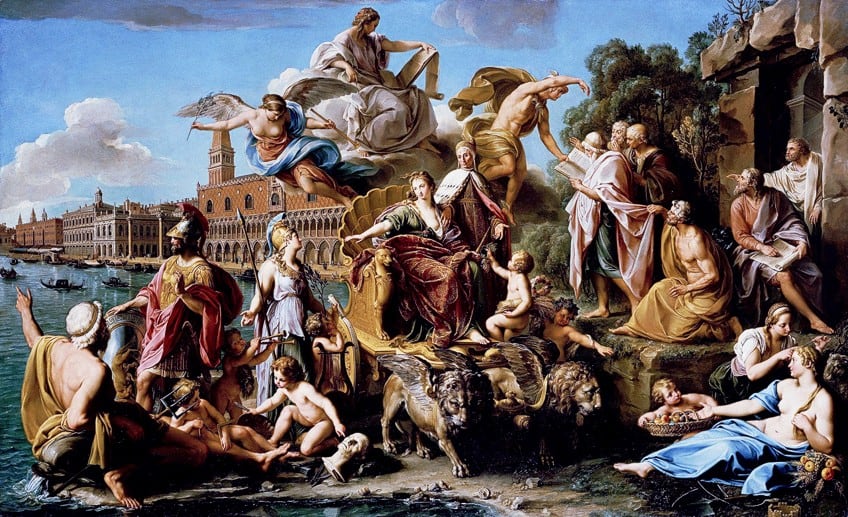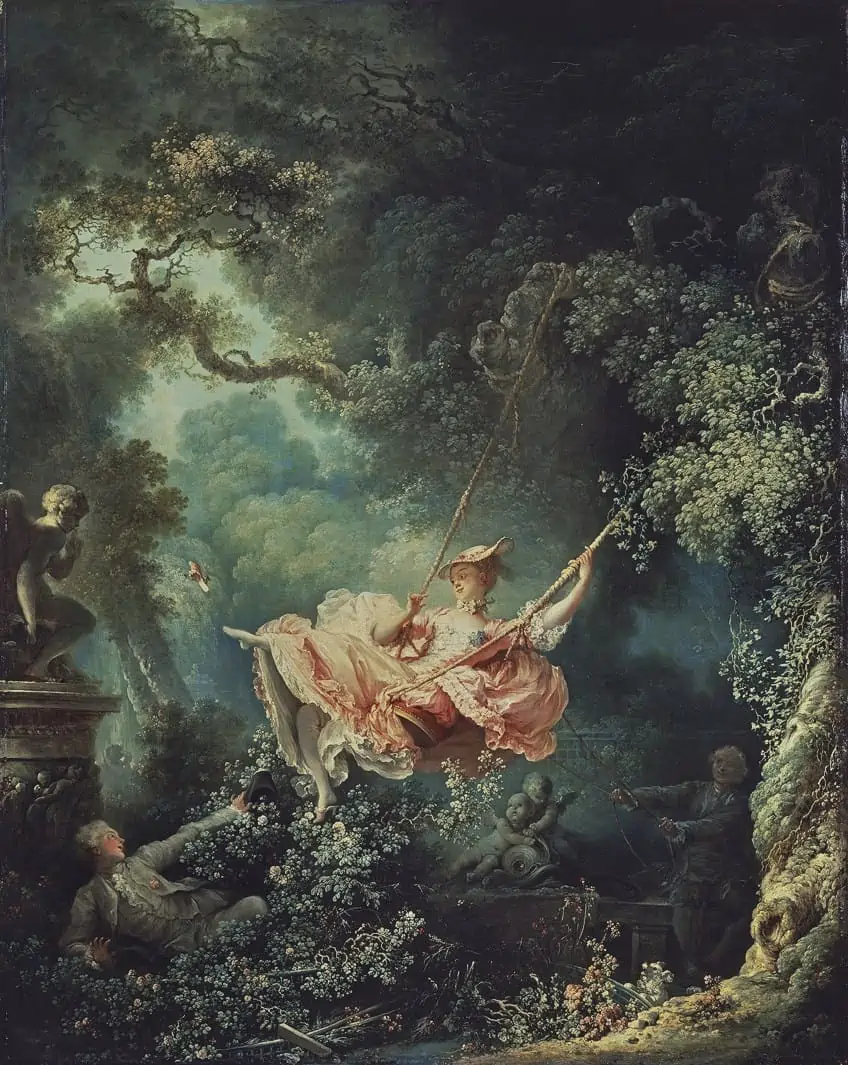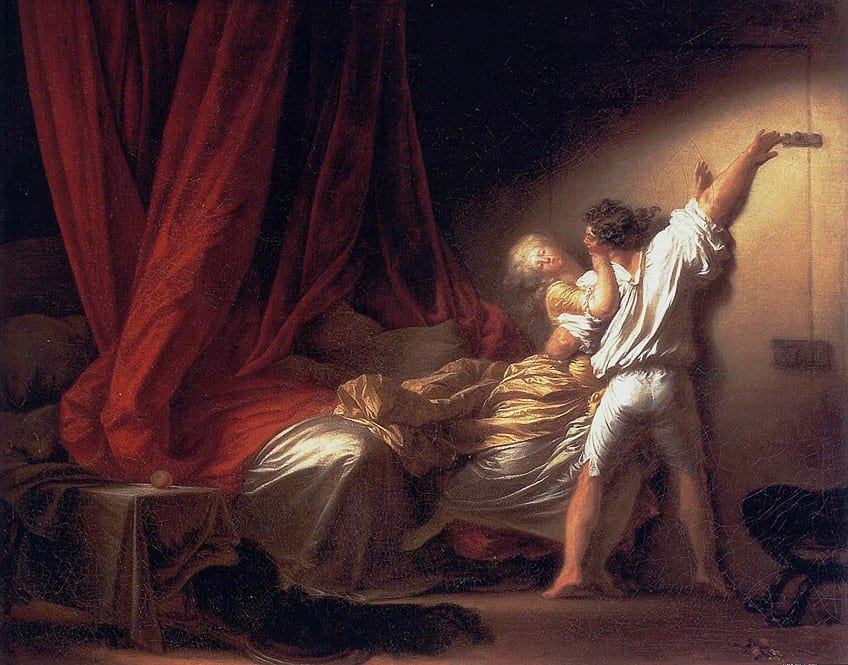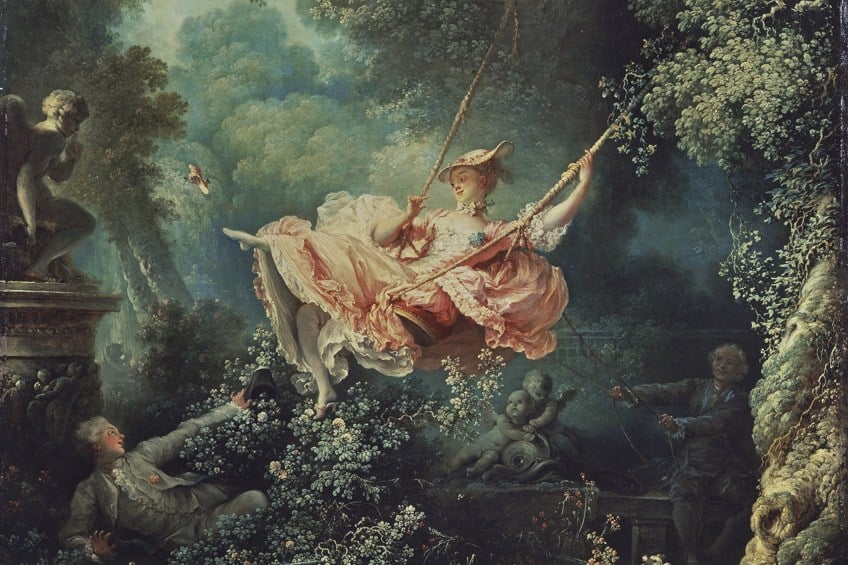Famous Rococo Paintings – A Look at the Best Paintings of Rococo Art
The Rococo movement is known for its extravagant and flamboyant style, which began in France in the 1730s as a reaction against the more formal Baroque style. The Rococo art movement soon spread to many parts of Europe, such as Russia, Germany, and Italy, and so on. This style drew inspiration from early Renaissance paintings, which were characterized by their elaborate detail. The Rococo art movement was one of the most prominent periods of art history. This article will be going into the particulars of 10 of the most famous and influential Rococo paintings.
A Brief History of the Rococo Art Movement
The Rococo art movement, known for its fine detail and extravagant look, flourished in 1800s France. The paintings created would often showcase playful and lighthearted scenes of the outdoors or gatherings, which featured wealthy, erotic figures and spiritual scenes. The spiritual nature of the movement would lead many of the artworks to be shown in churches. Rococo art was mostly showcased in paintings but would also make an appearance in decorative objects.
The word “Rococo” was derived from the French word rocaille. This word was coined from the method of decorating fountains and grottoes with shells and other natural mediums to create nature-inspired pieces.
Rococo artists were greatly inspired by nature and its movement, such as water and its flow of it, which can be seen in the organic flowing lines and shapes that are characteristics of these paintings. The movement’s paintings consist of extreme detail and decoration, a plethora of curves, asymmetry, and so on. These characteristics of the Rococo style would later be highly influential to later art movements, such as Futurism. Rococo’s style is luxurious and would be found in more private spaces, such as bedrooms (think Marie Antoinette’s bed-chamber).

Rococo paintings showcased a desire for intimacy, depicting scenes of young lovers enjoying their time spent together in lush gardens with music playing in the background. Interior scenes of erotic forbidden pleasures between men and women were also favored by Rococo artists. Often, these scenes would include mythical creatures, such as Cupids with arrows, gods, and goddesses. These depictions combined fantasy with reality.
Rococo art was created during what was known as the Age of Enlightenment, a new way of thinking about the world, where philosophy dominated Europe in the 1700s and 1800s. This era embraced the analysis of nature and science.
Naturally, the church was threatened by this way of thinking. The study of science and nature then began to intertwine with that of art and literature. Rococo art began to showcase this new way of thinking in its paintings, with an abundance of floral and organic imagery. As the 18th century carried on, Rococo began to be chastised for not creating art that focused on topics to do with the era’s more serious concerns. As the 18th century furthered on, Rococo began to blend into the Neo-Classical art movement.
10 of the Most Famous and Influential Rococo Paintings
The Rococo art movement was one of the most influential periods of art history, producing a multitude of artworks that have since become incredibly famous. The Rococo style later led to the influence of later art movements. This art period is celebrated for its elaborate and theatrical style, displaying the exorbitant fancies of 18th century France.
In the following list, we will be taking a look at 10 of the most famous and influential Rococo artworks.
Hercules and Omphale (1724) by François Lemoyne
| Artist | François Lemoyne |
| Date Painted | 1724 |
| Medium | Oil paint |
| Dimensions | 1,84 m x 1,49 m |
| Where It Is Currently Housed | Louvre Museum |
Hercules and Omphale is an oil painting created in 1724 by famous French Rococo artist François Lemoyne. Hercules and Omphale, one of Lemoyne’s most famous Rococo paintings, depicts a mythical love story. This story is about how the powerful Hercules had been sold as a slave to Queen Omphale of Lidia.
Hercules was eventually made to be the queen’s lover. Through this love, Hercules became gentler, and more feminine aspects of him began to show.
He would wear softer, more organic clothing and he became softer within himself as well. This is what Lemoyne has depicted in this artwork- a lovestruck, tame, and calm Hercules with his powerful, beautiful, and erotic lover, Omphale beside him.

They gaze into each other’s eyes lustfully. Omphale is above Hercules, and her arm around him, depicting a form of dominance over him, showcasing how this love has tamed and submitted him. Beside Hercules on the right, Cupid, a symbol of lust and love, can be seen.
This painting depicts how love can soften a man.
The story depicted by the painting as well as the painting’s style is typical of the Rococo style, showcasing love, seduction, and beauty. The painting’s look is soft with natural colors, mimicking the soft and natural love between Hercules and Omphale. Hercules and Omphale is a beautiful depiction of what Rococo encompassed: love, indulgence, and beauty.
The Triumph of Venice (1737) by Pompeo Batoni
| Artist | Pompeo Batoni |
| Date Painted | 1737 |
| Medium | Oil on canvas |
| Dimensions | 174.3 cm x 286.1 cm |
| Where it is Currently Housed | North Carolina Museum of Art |
Italian artist Pompeo Batoni was known for his mythological artworks, with The Triumph of Venice being one of his most well-known. In this painting, he took complete inspiration from the French Rococo art style. We see this through the mythological aspect of the artwork as well as the style overall.
The Triumph of Venice showcases the growth of fine art throughout Venice in the early 16th century. In this artwork, we see a personified Venice sitting upon a throne, being drawn forward by two winged lions.
To her right, we see the Goddess Minerva, a philanthropist of fine arts. To the right of Venice, we see Doge Loredan, who motions toward harvest offerings gifted by Ceres, a beautiful goddess seen in the right-hand corner of the painting. Above Venice, we see the figures of Fame.

This scene is shown moving forward, symbolizing the past being left behind and the glorious future ahead. To the right of fame, we see Mercury presenting Venice’s achievements to a group of historians and sages. The female figures are painted with soft, rounded bodies, some semi-nude. The men are painted with well-constructed muscles, thus showcasing the beauty of the human body.
The colors seen are electric blues, seductive reds, and golden yellows.
The colors used bring about a euphoric feel to the artwork. The faces of the figures are content. This display of the figures gives off an atmosphere of elation and new beginnings. This artwork, filled with beauty, luxury, and detail is classic of the Rococo style.
Diana Leaving the Bath (1742) by François Boucher
| Artist | François Boucher |
| Date Painted | 1742 |
| Medium | Oil on canvas |
| Dimensions | 57 cm x 73 cm |
| Where it is Currently Housed | Louvre Museum |
François Boucher, another famous Rococo artist, was a master at his craft of erotic and tantalizing artworks. His paintings were designed for seductive pleasure, yet they always kept a lighthearted warmth to them. He is celebrated for his beautiful and detailed nude scenes, such as Diana Leaving the Bath (1742).
In this artwork, we see a beautiful nude Diana being assisted by a youthful woman to her left.
To Diana’s right, we see arrows along with two birds and a hare, indicating a successful hunt. To the left, we see two hunting hounds. The women wear nothing but luxurious silks and pearls, with a crescent moon worn by Diana upon her forehead. They are surrounded by lush greenery and water.

The light emanating from the left highlights the beauty of the women’s figures, allowing for an ethereal yet sensual feel. The women are gracefully positioned, with the nipples of Diana brushed with a rouge color. This accentuation of sensualities is typical of the Rococo style, designed to titillate.
The color palette of sky blues, lush greens, and luminous white add to the ethereal look overall.
The women’s bodies, with a soft and rounded look, flawless complexions, and pink lips are delicately feminine – the ideal look of a woman during the French Rococo era. The painting was first exhibited along with a series of small erotic paintings at the Paris Salon in 1742. The painting showcases the Rococo style exquisitely.
The Interrupted Sleep (1750) by François Boucher
| Artist | François Boucher |
| Date Painted | 1750 |
| Medium | Oil on canvas |
| Dimensions | 81.9 cm x 75.2 cm |
| Where it is Currently Housed | The Metropolitan Museum of Art |
The Interrupted Sleep by François Boucher is one of two paintings that were made to be hung at the Bellevue Château. The painting is a combination of sensuality hidden in innocence. In The Interrupted Sleep, we see a shepherd about to tickle the nose of a beautiful woman in slumber, inevitably waking her up. Behind the shepherd, his sheep and sheepdog are seen.
The two figures are surrounded by lush and bright greenery, adding to the playful nature of the painting. A delicate and simple white dress with pink accents is seen to be worn by the sleeping female. Beside her is her woven hat with a blue headband, and there is a pink rose worn in her hair.

Her skin is fair with rosy lips. She is barefoot, which showcases the relaxation and serenity present throughout the painting. Her facial expression is calm and at ease, unaware that the shepherd is about to tickle her nose. The shepherd wears a red waistcoat with a loose blouse underneath. His facial expression is cheeky, showing his almost sensual excitement at teasing the female.
The painting is rich in detail, with playful and light brushstrokes. The coloring used is beaming and playful. This artwork is truly a beautiful showcase of the Rococo style.
An Allegory with Venus and Time (1758) by Giovanni Battista Tiepolo
| Artist | Giovanni Battista Tiepolo |
| Date Painted | 1758 |
| Medium | Oil on canvas |
| Dimensions | 292 cm x 190 cm |
| Where it is Currently Housed | National Portrait Gallery |
An Allegory with Venus and Time by Giovanni Battista Tiepolo is an oval-shaped painting commissioned to be displayed on the ceiling in a palazzo by the Contarini family. The painting was created to be seen from below. The shape of the painting, an oval, was incredibly innovative, different, and attention-grabbing at the time.
The shape enhances the beauty of the painting.
An Allegory with Venus and Time celebrates a new heir, Venus, the goddess of fertility and love. The painting is filled with mythological beauty, consisting of Cupid, Venus, and a personified Time. A semi-nude Venus draped in soft pink and white cloth is seen handing over a baby with a defined face to a male winged figure, Time, cradling the baby in his arms.

Above Venus, we see two white doves intertwined, a symbol of love and connection. In the clouds above, we see three figures looking down toward the infant whilst scattering flower petals. Below, Cupid, Venus’ son, is seen holding a bunch of arrows. Cupid is the symbol of love, bringing two people together by using his arrows. Soft lighting and coloring are used in this painting. Venus’ soft and pale skin with pink cloth contrasts strikingly against Time’s dark, rough skin and blue drapery.
This painting beautifully showcases the beauty of mythology through love and personifications, which the French Rococo style was known for.
The Swing (1767) by Jean-Honoré Fragonard
| Artist | Jean-Honoré Fragonard |
| Date Painted | 1767 |
| Medium | Oil on canvas |
| Dimensions | 81 cm x 64 cm |
| Where It Is Currently Housed | Wallace Collection, London, United Kingdom |
The Swing is an oil painting created in 1767 by Rococo artist Jean- Honoré Fragonard, one of the leading decorative artists of the time. It is regarded as one of the most famous examples of French Rococo artworks. Fragonard specialized in playful, erotic compositions that are typical of the Rococo style. The Swing depicts this perfectly and is now his most well-known painting.
The Swing is believed to have been appointed by the Baron de Saint-Julien, who asked to have the painting be of his mistress, while he could be seen in the painting below her, looking up her dress.
The Swing depicts a beautiful young woman in an extravagant pink dress being pushed on a swing by a man hidden by the lush gardens in the background. Beneath the beautiful woman, to the left of the painting, lies a young man, admiring her.

At first glance, the painting seems innocent, but with deeper inspection, a more sensual and erotic vision is revealed, a typical theme seen amongst Rococo artists and their work. As the young woman is being pushed on the swing, the man beneath her can look up her skirt. She seemingly allows him to do so as she flicks her legs back and forth. Her right shoe flies off toward the Cupid figure behind the man. This symbolizes the lust and desire she feels toward the man, as Cupid is a symbol of desire, erotica, and love.
As her shoe flies off, her ankle is revealed, which at the time, was an incredibly sensual thing to be shown. The playful energy of the painting is accentuated by its light pastel colors and ethereal lighting. The frills of her dress mimic the lush surrounding gardens, making for lively energy throughout the painting.
This masterpiece perfectly showcases what Rococo art stands for and has indeed become an icon of the French Rococo art movement.
The Blue Boy (1770) by Thomas Gainsborough
| Artist | Thomas Gainsborough |
| Date Painted | 1770 |
| Medium | Oil on canvas |
| Dimensions | 177.8 cm x 112.1 cm |
| Where it is Currently Housed | The Huntington Library, Art Museum, and Botanical Gardens |
The Blue Boy by Thomas Gainsborough is his most famous artwork, which was said to be the most famous artwork at the time of the French Rococo era. The painting is a full-length portrait, said to be of Jonathan Buttall, as he had earlier owned the painting. It is life-sized.
The painting was created with predominately cold-hued colors as a contradiction to rivaling artist Joshua Reynolds, who said that cold colors should be used simply to highlight the predominately warm colors, such as reds and yellows.

What brought mass fame to The Blue Boy is the contradiction and opposition of personalities between Reynolds and Gainsborough. Gainsborough enjoyed creating portraits opposite of what academic art was thought to be. This portrait is not only a perfect depiction of the Rococo style but also of a historical costume study.
The painting, through its course of different ownerships, gained immense fame, with tens of thousands of views during the Rococo era. In The Blue Boy, we see the boy staring directly at us.
The facial expression is calm and the stance is confident. His complexion is fair with rosy cheeks. His left arm rests on his hip and his right arm hangs whilst holding a black hat. He wears a striking blue costume, contrasting the duller but still detailed background. The way both the background and foreground are painted, with beautifully rounded brush strokes, is typical of the Rococo Style. A sense of opulence is also shown by the beautiful and intricate costume worn by the boy. This painting truly showcases the essence of the French Rococo art style.
The Lock (1776 – 1779) by Jean-Honoré Fragonard
| Artist | Jean-Honoré Fragonard |
| Date Painted | 1776 – 1779 |
| Medium | Oil on canvas |
| Dimensions | 74 cm x 94 cm |
| Where it is Currently Housed | Louvre Museum |
The Lock is the most famous artwork created by Rococo artist Jean-Honoré Fragonard. The scene depicts two lovers sensually intertwined, whilst the man proceeds to bolt the door for privacy. This painting is truly erotic and sensual, showcasing love through passion.
Before the painting was created, several sketches were completed. The painting began as an outline, with the paint added in layers.

We see luxurious bright-red curtains draped on the bed, which is covered in beautiful nude silk. The luxurious look of the red curtains and silk adds to the intensity of the artwork, symbolizing lust and love. The female wears a silk gown and the male is in his undergarments. They are completely interlaced with each other, with the male’s gaze firmly on the female. This showcases the intensity of the moment, that not for one second does his attention turn from his lover.
The colors are warm, with the light cascading across the lovers. This scene depicts love with intensity and purity. This painting is a true representation of the beauty and sensuality of the French Rococo style.
Marie Antoinette with a Rose (1783) by Élisabeth Vigeé Le Brun
| Artist | Élisabeth Vigeé Le Brun |
| Date Painted | 1783 |
| Medium | Oil on canvas |
| Dimensions | 116.8cm x 88.9cm |
| Where it is Currently Housed | Palace of Versailles, Versailles |
Élisabeth Vigeé Le Brun was the court painter for Queen Marie Antoinette of France. Le Brun portrayed Marie Antoinette delicately and tenderly in this painting, wearing a chemise. The chemise was designed by the queen’s favorite dressmaker, Rose Bertin.
The portrait was removed from the Salon, however, as it was a shock to see the queen portrayed in such attire.
The chemise displayed was constructed from imported cotton instead of French silk. The original painting was immediately repainted in order to be exhibited. A larger, more formal painting was then created in the same year to appease the Salon. The queen is presented in the same pose and same expression. At the center of both paintings, we see a pink cabbage rose, which was the queen’s favorite flower.

In the original painting, the queen is wearing a brilliant blue gown, trimmed with white lace with a matching hat worn with feathers. Her skin is fair and her complexion is flawless with rosy cheeks and lips. Pearls are worn around her neck and wrists. The background is filled with lush greenery, giving the painting a luxurious feel that exudes pleasure and wealth. Nature is shown throughout, typical of the French Rococo style.
The artwork is lighthearted and playful with exquisite detailing throughout, beautifully displaying the French Rococo style.
Marie Antoinette and Her Children (1787) by Élisabeth Vigeé Le Brun
| Artist | Élisabeth Vigeé Le Brun |
| Date Painted | 1787 |
| Medium | Oil on canvas |
| Dimensions | 275 cm x 216.5 cm |
| Where it is Currently Housed | Palace of Versailles, Versailles |
In July 1785, Marie Antoinette’s image was damaged by an event known as “the Affair of the Diamond Necklace”. Marie Antoinette and Her Children was created by Élisabeth Vigeé Le Brun in an effort to restore and improve the queen’s public reputation.
The painting was created to turn the focus away from the event and toward Marie Antoinette as a queen and as a caring mother.
In this artwork, she is seen surrounded by her children. She is wearing no jewelry and a simple gown to further increase sympathy toward herself from the public. An empty cradle is seen to the left of the queen, indicating the loss of her youngest child. This was done to further increase sympathy toward the queen.

The painting is life-sized, displaying the queen in a red velvet gown. Her youngest son sits on her lap. Her daughter gazes lovingly toward her, with her eldest son, the Dauphin, standing to her right. The painting consists of warm-hued colors that appeal to the viewer’s gaze.
The painting is rich with religious symbolism, which appealed to the French viewers at the time.
The queen’s lack of jewelry symbolized that her children were her true gems. The children and queen’s complexions are fair, with rosy cheeks and lips, showcasing their health and beauty. The costumes worn are luxurious yet still humble when compared to other costumes worn. This painting is rich in detail and color, making it a true vision of the French Rococo style.
Paintings from the Rococo art period have shown to be extremely important and pivotal in the fine arts world, as they are still frequently studied and admired. This style has also continued to inspire many artworks and art movements to this day. Only 10 of the most famous and influential artworks have been discussed in detail, but there are hundreds more waiting to be explored. We hope you decide to delve deeper into the world of famous Rococo artworks.
Take a look at our Rococo paintings webstory here!
Frequently Asked Questions
How Would You Describe the Rococo Style?
The Rococo style is characterized by playful, lighthearted, sensual, erotic, and mythological themes. The colors are rich and sensuous and the brushwork is light. These paintings are known for their exuberant detail.
What Is the Difference Between the Rococo and Baroque Styles?
The main difference between Rococo and Baroque styles is that the Baroque style is defined by dramatic, imposing, and exaggerated late-European style, while the Rococo style is defined by its light-hearted, more intimate, playful, sensual, and erotic scenes.
What Makes Rococo Art Different?
Rococo art disregarded the more sought-after firm symmetry that Baroque art was known for. Rococo was inspired by nature and its natural flowing forms, with sea shells and gilding being incorporated into the paintings. This all created a more at-ease, lighthearted feel.
Jordan Anthony is a Cape Town-based film photographer, curator, and arts writer. She holds a Bachelor of Art in Fine Arts from the University of the Witwatersrand, Johannesburg, where she explored themes like healing, identity, dreams, and intuitive creation in her Contemporary art practice. Jordan has collaborated with various local art institutions, including the KZNSA Gallery in Durban, the Turbine Art Fair, and the Wits Art Museum. Her photography focuses on abstract color manipulations, portraiture, candid shots, and urban landscapes. She’s intrigued by philosophy, memory, and esotericism, drawing inspiration from Surrealism, Fluxus, and ancient civilizations, as well as childhood influences and found objects. Jordan is working for artfilemagazine since 2022 and writes blog posts about art history and photography.
Learn more about Jordan Anthony and about us.
Cite this Article
Jordan, Anthony, “Famous Rococo Paintings – A Look at the Best Paintings of Rococo Art.” artfilemagazine – Your Online Art Source. July 8, 2022. URL: https://artfilemagazine.com/famous-rococo-paintings/
Anthony, J. (2022, 8 July). Famous Rococo Paintings – A Look at the Best Paintings of Rococo Art. artfilemagazine – Your Online Art Source. https://artfilemagazine.com/famous-rococo-paintings/
Anthony, Jordan. “Famous Rococo Paintings – A Look at the Best Paintings of Rococo Art.” artfilemagazine – Your Online Art Source, July 8, 2022. https://artfilemagazine.com/famous-rococo-paintings/.



